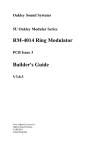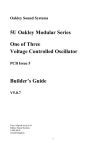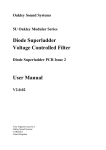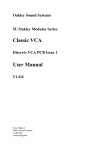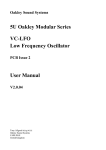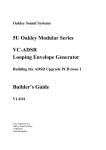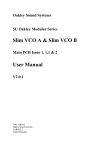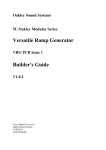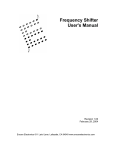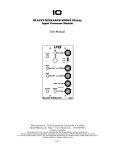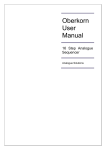Download `Dizzy` User Manual and Builder`s Guide
Transcript
Oakley Sound Systems ‘Dizzy’ The Power Distribution Board PCB Issue 3 User Manual and Builder's Guide V3.2.0 Tony Allgood B.Eng PGCE Oakley Sound Systems CARLISLE United Kingdom Introduction This is the User Manual and Project Builder's Guide for the issue 3 Dizzy module from Oakley Sound. This document contains a basic summary of its operation and some information about how to connect it to your power supply and modules. For general information regarding where to get parts and suggested part numbers please see our useful Parts Guide at the project webpage or http://www.oakleysound.com/parts.pdf. For general information on how to build our modules, including circuit board population, mounting front panel components and making up board interconnects please see our Construction Guide at the project webpage or http://www.oakleysound.com/construct.pdf. The Dizzy – A Modular Distribution Board This is a simple distribution board that enables you connect up to twelve Oakley, Blacet or MOTM modules together. It also features eight 0.1” headers to allow for normalisation paths for keyboard CV and gate. The larger headers are arranged in three blocks of four. The one master supply inlet uses a 0.2” (5mm) screw terminal connector. An optional earthing point is provided to tie the panels connection to earth potential. The issue 3 Dizzy board fitted with MTA156 power headers and Molex KK 0.1” headers for the Oakley Buss. The four way power inlet has not been fitted since this particular board will be hard wired into an Oakley PSU. 2 The Oakley Power Buss In an ideal world I wanted the Oakley power buss to be based on a five way 0.156” MTA or Molex connector. This would contain +15V, -15V and three grounds. One ground would be the safety ground; this would be connected to the front panels and then directly onto the main’s supply earth. The second would be a clean ground for all the analogue modules to take their supply reference, the zero volt line, ie. 0V. The third would be a dirty ground. This would be the ground reference for things like the noisy digital circuitry and LED switching. However, this system would be incompatible with the MOTM modular which has a four way connector for its analogue modules. So the question now remained, how could I make my system work with MOTM, yet still retain some of the features I needed. The chosen Oakley power buss comprises of +15V and -15V lines with two grounds. These grounds are not connected together as in the MOTM. They are joined only at the power supply in a wholly Oakley Modular. In an Oakley modular one of the grounds, pin 2, goes straight to the power supply’s star point. This is the analogue reference point and is correctly called 0V or module ground. This is the same as the MOTM ground. The second ground is on pin 3. This is also connected to the power supply’s star ground. But this ground is connected only to the metal lugs of the sockets on each module and nothing else on the module. It is this connection that sets the potential of the patch lead’s screening and the metal case of the modular. This way it is impossible for ground currents to travel down the inserted patch cords, since the panel is isolated from the system ground except at one point. However, this only works if ALL your modules follow this rule. If you insert just one MOTM module into this system, the ‘benefits’ are lost. MOTM modules can be modified to allow full Oakley compatibility although this should be done as you are building the module. Modifying a completed MOTM module is possible, but the reverse side of the PCB must be accessed so that you can cut the required tracks. But I said earlier that the MOTM and Oakley power systems were compatible. And indeed they are. Any Oakley module will work in a MOTM system. And vice versa. But you will not get the inherent advantages of a two ground system if you mix and match systems. Having said all that I have yet to hear any problems related to ground currents in any MOTM or MOTM/Oakley systems. 3 Building the Dizzy board for your needs The Dizzy board can be utilised very easily. Simply solder twelve 0.156” headers to your board, making sure that pin 1 goes towards the top of the board. You can use either Molex or Amp MTA headers. The latter is the standard fixing on all Oakley and MOTM ready made modules. These are IDC (insulation displacement cable) systems and require a special tool to jam the wire into the specially made connectors. Molex is a ‘strip and crimp’ system, that requires you to strip each wire and then crimp (or solder) the wire into individual terminals. The terminals are then pushed into the housing and held in place by a little spring loaded clip. The MTA system is good if you have a lot of cables to make, but that IDC tool is very expensive for what it is. The Molex system is cheap and works just as well, but does take longer to prepare the assemblies. Connect your power supply to the header marked INLET with four wires. The Dizzy board uses a 5mm screw terminal connector. For example, Rapid part number: 21-0116. One four way type is soldered into the Dizzy board, and the connecting wire is fed into the appropriate hole and screwed into place. Additional board space has been given up to fit two diodes. Use 1N4001 or 1N4004 devices. They don’t have to be fitted, but they may help if there ever is a problem with your power supply and/or wiring. These two diodes prevent the positive rail from becoming negative, and vice versa. Please make sure you fit them in the right way. The white band on the diode should match up with the horizontal band on the PCB legend. There are spaces for three 'resistors' on the Dizzy board. These are actually spaces for some optional wire links. They allow different earthing arrangements to be set up within your modular. R1 connects between the PANELS and 0V lines, R2 connects between the EARTH pad and PANELS. R3 connects between the 0V and pin 2 of the normalising buss. Using the Oakley PSU with the recommended AC power adapters you would only need to fit a wire link in position R3. R1 and R2 links are not fitted and are left empty. R3 simply ties the copper trace between the CV and gate lines of the Oakley Buss to ground. If you are not using the Oakley Buss or want to use the middle pin for another job you should omit R3. The board is arranged in three sets of four headers. It is best to keep more ‘delicate’ modules, like MOTM VCOs, to the two left hand sections. These headers have the shortest path back to the power supply and are the most stable. Each set of four is star wired back to the INLET header, and this should reduce any likelihood of supply line interference between the sets. The connections between each header in the sets are done with tracks on both sides of the boards. This is to try and keep the potential drops between the modules as low as possible. 4 Connecting the Dizzy to the Power Supply The main cable connecting the power supply with the Dizzy board should have four thick wires and be as short as possible. I recommend using wire that is at least 0.5mm2 and no longer than 30cm. Name Pin number Source +15V Module GND (0V) Panels -15V 1 2 3 4 Power supply positive Power supply 0V Power supply 0V Power supply negative The Dizzy should be mounted as close the power supply as possible. It is far better to keep the four interconnecting wires short and the module power leads long rather than the other way around. Even if it does mean more wiring overall. Using the Oakley Power Supply (Oakley PSU) to drive the Dizzy is easy. Simply connect four wires from the PSU to the Dizzy board using the four-way screw terminals. The Oakley PSU will support up to two Dizzy boards directly. Up to four Dizzy board can be made to fit but be sure to make sure each Dizzy board takes its power from the PSU module and not another Dizzy board. That is, do not daisy chain Dizzies together. One final point about using multiple Dizzy boards; watch your maximum current draw. Just because you can have up to 24 power headers does not mean you can actually power 24 modules. Each module takes current, the actual amount is given on the project webpage and User Manual, and your power supply can only supply a certain amount of current. 5 The Oakley Buss and Normalisation. Normalising is the process by which some signal paths are already made for you. In other words no patch leads are needed to make those connections; they are connected internally. However, normalising can always be overridden. The name itself comes from the use of normalised connections on sockets. When a socket does not have a jack inserted it is in its normal position. There is often a connection between the signal lug of the socket and an extra contact called the NC (normally closed) lug. It is this third lug on the socket that is used for the normalisation. Inserting a jack plug will break the connection between the NC and the signal lug. To help us understand where normalisation is useful consider a VCO with a 1V/octave socket on its front panel. It is most likely to be used to for a keyboard control voltage (KCV). To connect KCV to this socket one would ordinarily need a patch lead. But imagine a system where you have four VCOs and two VCFs that all need the same KCV signal. It can take many patch leads to do this; seven if you have a large multiple panel. Now suppose that the NC lug of every 1V/octave socket is connected to a common KCV bus. All six modules can now be driven without the need for those seven patch leads. This saves you leads, time, and also gives you a better working environment because you don’t have to fight your way through a tangle of leads to get to the module’s knobs. Inserting a jack into one of those sockets would disconnect it from the KCV bus, so you still have complete modularity. Normalising is frowned upon by some people, and loved by others. Most modulars do have some form of normalising. The Roland System 100 probably has the highest degree of normalising. You don’t even need a patch lead to get that one to sing. The MOTM has no form of external normalising, although there are normalising routes within each module. When I first started building my own modular system, I thought that normalisation was a bad thing. Like preset memory patches it would stifle creativity by making things a little too easy. However, in practice I noticed that I was routing CV and gate to the same locations in the modular for almost all my patches. So I decided to provide some form of limited normalising. I chose to normalise just KCV and gate. No audio normalisation was allowed. It was easy to do, and proved very effective. The issue 3 Dizzy PCB includes a three way normalising buss which we call the Oakley Buss. This Oakley standard, originally created with the Dizzy issue 1 PCB, gave us just two lines; the KCV and Gate busses. These are accessed by the three way 0.1” headers. Pin 1 of each header is KCV and pin 3 is Gate. Pin 2 was connected to ground on the first board, but some customers modified the board to give a third CV bus. This issue of the Dizzy board leaves it floating so you can now use it to normalise a third CV line without cutting any PCB tracks. However, it is usually connected to 0V ground via R3. If you do not intend to use pin 2 for anything, make R3 a wire link to provide some isolation between the other two lines. The Oakley VCOs, ADSR, midiDAC and VCO Controller already have the three pin headers on the main or socket boards ready for direct connection to the Dizzy. However, you should note that, although the Oakley Buss header is a three way connector, the actual interconnect does not require all three wires connected. The actual wires you do need is determined by the module type. 6 For example: The Oakley VCO is connected only to pin 1 of the Oakley Buss. This is the connection carrying KCV. This means you need to use only a single wire that is terminated in a 3 way housing at either end. The first location of the housing, pin 1, is the only one used, with the other two locations being left empty and no other wires needed. Likewise the Oakley ADSR module needs only to be connected to pin 3 of the Oakley Buss. This is the connection carrying the gate. So this time you only need to wire up pin 3 and positions 1 and 2 are left blank. The midiDAC, however, generates the CV and gate lines for your modular so this should have two wires connected on its buss connector. Both pins 1 and 2 are used on this module. You could make a generic Oakley Buss connector that would be suitable for all modules using the buss. This would comprise of two wires terminated at each end in three way housings but with the middle location left unused. On no account should an interconnect with three wires fitted be used to connect the Oakley Buss to any module. The middle location, pin 2, is ground on the module and this should not be connected to the Dizzy or midiDAC modules. Connecting the two grounds in this way could induce earth loops and introduce hum or crosstalk in your system. Any module not fitted with a suitable three way header that you wish to connect to the Oakley Buss will need to have a suitable length of wire terminating in a 3-way 0.1” header. Again, you’ll probably only need to use one pin for each module, since very few synthesiser modules actually use KCV and gate together. The wire end of the interconnect needs to be connected to the NC lug on the relevant socket, ie. 1V/octave or gate. Be sure that you remove any existing normalising on the socket that you want to use. Note that some MOTM and older Oakley modules have the NC lug connected to ground. The furthest left hand header can be joined to the midi-CV convertor, or an interface panel. You may feel that adding little single, or double, wire tails to your MOTM modules is not a good idea. It is a little untidy. But I certainly would recommend to try it out if you use your modular for straightforward musical applications. Tony Allgood © August 2005 Updated November 2011 7












